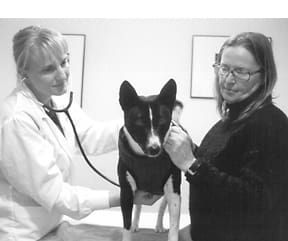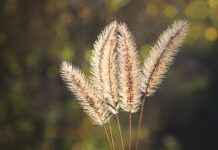In the following article, holistic veterinarian Randy Kidd writes about the role of the healer’s intention, or purposeful thoughts, as he or she works to improve an animal’s health. Dr. Kidd was chiefly concerned with healing, but his words can be applied to anything that you do with a dog, including feeding, petting, and (especially) training. Most trainers would agree that it helps immeasurably to be very clear about what you are asking for when you work with a dog – even to the point of visualizing in your mind the behavior or movement you are seeking from your dog. Unquestionably, your focus will help you communicate your wishes to your dog, making it easier for him to interpret and understand your cues. Life is demanding and stressful for many people these days. We rarely have enough time to be as reflective as we’d like. But as you work with and care for others, including your dogs, take a moment to focus purposeful thought on your tasks. I’m certain that WDJ’s contributors – experts in training, behavior, health, and nutrition – would concur: Food is better when prepared with loving, healthful intent; massage is more beneficial when directed with focused energy, and behavioral problems disappear when communication between teacher and canine pupil is positive and clear. –Editor ———- The first time I heard the term “intention,” as applied to a healing method, was after I’d been a practicing veterinarian for about 30 years. I was taking an animal chiropractic course when a chiropractor-instructor commented, “Chiropractic is all about intention. Think about exactly where you want that spinal vertebrae to be and then let that intention help you with how you want to move it back into alignment. Your focused intention is your best ally when you’re doing chiropractic.” At the time I thought it was interesting that I’d never heard the term “intention” applied to medicine before. But I took my chiropractic teacher’s admonitions to heart, and now, before each adjustment, I spend a moment to focus my intention before I do any mechanical manipulations. In the ensuing years I’ve learned a few things about applying chiropractic to animals, and I’ve added these applications to my focused intentions. For example, early on I learned that animals will bite when your chiropractic technique is too heavy-handed! So, now my intention is to adjust an animal without causing pain. It’s a subtle thing, but once I changed my intention from simply “proper adjustment” to “proper adjustment without pain” I noticed I worked with a lighter touch, and it was obvious the animals were responding in kind. One of the first things I noticed when I began taking courses in alternative medicines was how different their goals were from western or allopathic medicine. While allopathic medicine’s intention is to “cure” the physical component of the disease, the intention of alternative medicines is to balance the patient’s collective body/mind/spirit. The word allopathic comes from the Greek allos, other or opposition, and pathic, from the Greek pathos, or disease. Thus, allopathic means a treatment “other than, or in opposition to the disease.” Western medicine’s intention is to find the “bug” (or other etiology) that caused the disease, and then specifically attack the perceived problem. With this as its intention, western medicine uses a lot of war-term analogies: we are “fighting disease;” for this case we may need to bring out the “bigger guns” (more potent antibiotics); we need to “eradicate” this bug; etc. In contrast, almost all alternative medicines are aimed at enhancing the patient’s inner ability to respond to the (almost always multiple) causes of the disease. You can witness this in homeopathy’s intention to enhance the patient’s “vital force,” acupuncture’s intention to enhance the patient’s chi, and chiropractic’s intention to enhance the patient’s “innate intelligence.” So, when you’re using alternative medicines, your thinking needs to change to an intention that is almost the opposite of western medicine’s intention. Or as some of us like to put it: “Western medicine and alternative medicines are looking at the same ‘mountain’ of a patient; we’re just looking at that ‘mountain’ from completely opposite sides.” Intention is integral to holistic medicine The more time I spend with my practice of alternative medicines, the more I see that holistic medicine is much more than a simple application of a medicine, whatever magical medicine the practitioner currently uses. As I stated in my practice model (“Building the Foundation of Health,” March 2001) I feel medicine – whatever the medicine – is merely the “nudger” or “tweaker” that may help move the patient to better health. The true intention of holistic medicine, in my mind, is to empower the patient to a healthy reunion with nature, to recreate balance, to return the patient’s inner powers for health and healing, to re-establish more natural relationships, and to help create healthy life-style choices. I teach at a university that is (among other things) scientifically validating non-local and intuitive approaches to diagnosis and healing. Non-local diagnosis and non-local healing (sometimes referred to as intuitive diagnosis and healing) occur when a practitioner is able to effect a diagnosis or a cure from a distance, without seeing the patient. Now there’s a subject that at one time I thought was much too woo-woo, even for me! The problem is, I’ve seen non-local diagnoses that were accurate and non-local healings that were completely successful. I’ve seen both of these far too often to dismiss them. And, as a matter of fact, there’s a lot of scientific evidence to support the curative value of non-local prayer, and intuitive diagnosis has been scientifically shown to work. Through my work at this university, I’ve recently become involved with two different groups of healers: Native American healers, and what I call “natural healers” – healers who seem to be gifted with natural healing powers and often don’t use any specific medicine other than their own ability to heal. Interestingly, when asked what is the most important aspect of their healing abilities, both these groups of healers almost always answer, “Intention.” It seems to be a common thread that unites them all. In fact, in the Native American way of healing, intention is the one crucial ingredient for all medicines. Healings are given from Spirit through the medicine man or medicine woman who is able to access Spirit via his/her good intentions. In their way of thinking (and I happen to agree with this), even the herbs they may use must be collected and utilized with proper intention or their powers to heal are greatly diminished. I have questioned dozens of healers who use unconventional methods, and they all say that it’s their intention that gives them the ability to diagnose or heal. They all claim to have a tremendous ability to focus their intention to the point that both the information they receive (often claimed to be from Spirit, or the Universe, or Jung’s Collective Unconscious, or their personal concept of God, or whatever they see as a Higher Power) is accurate, and their healing abilities (again, most often from Spirit) can be focused and directed in a helpful manner. My intention through me A further key to intention I am learning from the “natural healers” I’m working with is that the most efficient and effective way to utilize the healing powers of Spirit is to let those powers flow through. Here’s where it becomes crucial, at least in the minds of the most successful of the “natural healers,” to not let any of your personal stuff interfere with the healing intent of the Universe. This, of necessity, means that the healer needs to walk her/his talk, so to speak. True healers must practice the methods of personal empowerment that they recommend for their patients. In addition, many of the natural healers also have a way, often involving some form of ritual, of purifying their intention. They often also have some way that involves an intensifying of their focus, a method to always bring their focus back to their intention. For me, purifying my intention is now related to removing my ego from the healing process. I have learned that trying to prove one or the other of the alternative medicines I use is better than another (or better than western medicine) is a matter of egoistic pride; that always expecting miraculous results is a matter of a bloated ego; and that believing I am the one who is performing the “healing” (rather than Spirit) is a matter of an overinflated and misdirected ego. The most difficult deflation of personal ego that the natural healers have finally been able to make me to understand is that they (and especially I) must learn to accept the intention of the Universe. Intention of the Universe When I expect positive results to occur with every treatment, that’s a matter of my ego getting in the way of the ultimate designs of the universe. What the natural healers have taught me is that, no matter how good you are as a healer, you are always subject to the natural laws of the universe. “Thy will be done” is another way of putting this. In other words, it is the realm of divine intention that will ultimately determine the outcome of all our treatments. Now, I’m not a particularly religious guy, but embracing the simple concept of “Thy will be done” has helped me with my healing efforts more than anything else I’ve ever learned. It has allowed me to purify my intention, and it has let me focus on what I can do within my own abilities. And, most interestingly, it has let me get on with the work I am capable of doing without my ego continually crying about my lack of successes, my inabilities, and my personal fallibilities. What I’ve presented here is pretty much a chronological account of how I’ve learned to purify, to focus, and to utilize my intention and the intention of Spirit to help me with my holistic healing efforts. Sheesh, looking back on the process – from the first hint I had that intention was involved with any healing method, to my current realization that intention is perhaps the single most important component of any healing – has taken me more than a dozen years to complete. Hopefully, you’ll be a faster learner than I was. -by Dr. Randy Kidd Dr. Randy Kidd has a DVM degree from Ohio State University and a Ph.D. in Pathology/Clinical Pathology from Kansas State University. He is a past president of the American Holistic Veterinary Medical Association, and author of Dr. Kidd’s Guide to Herbal Dog Care and Dr. Kidd’s Guide to Herbal Cat Care.
The best in health, wellness, and positive training from America’s leading dog experts
© Belvoir Media Group, LLC. All rights reserved.






